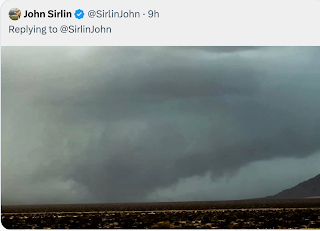A Microburst That Looks Like a Tornado
As I describe in Warnings: The True Story of How Science Tamed the Weather one of the reasons it was so difficult to discern that there was a distinct phenomena called a "microburst" was because they were sometimes reported as a tornado and they did damage. So, "tornado," right?
This morning, we had high-based thunderstorms in the Wichita area and I took this photo of a microburst that -- to the untrained eye -- would look like a tornado, complete with a debris cloud near the ground.
To my eye, the giveaway (other than the fact the atmosphere was not conducive to tornado development) is there was no rotation at all. A tornado at this distance would have shown clear rotation.





This comment has been removed by the author.
ReplyDeleteIf it happened with bad enough light conditions, you'd be unable to discern the lack of rotation.
ReplyDeleteThat is true but it was clearly not rotating this morning.
ReplyDeleteMike - ar microbursts capable of causing the same level of damage as a tornado? I remember late June 28, 1987, straight line winds injured 16 at Waconda Lake, and demolished the gymnasium at the local tech college on the north edge of Beloit. At the time, the sheriff department was saying a microburst was responsible for the gym destruction.
ReplyDeletehttp://articles.chicagotribune.com/1987-06-29/news/8702170639_1_winds-storms-cuts-and-bruises
Yes, Joe. Winds in the strongest downbursts have been measured at 150 mph which is an upper F-2 tornado.
ReplyDeleteTo me, it seems extremely unlikely that a downburst could produce wind speeds much stronger than that but since F-3 starts at 158 mph it is possible for the very strongest downbursts might reach that speed.